Southern Athletic Conference
Faculty representatives from seven Southern colleges met on December 22, 1894, to discuss organizing an athletic association. The schools were:
- University of Alabama
- Agricultural and Mechanical College of Alabama (now Auburn)
- University of Georgia
- Georgia School of Technology
- University of North Carolina
- University of the South (Sewanee)
- Vanderbilt University
The meeting, organized by Dr. William Dudley, a chemistry professor who was president of the Vanderbilt Athletic Association, led to the formation of the Southeastern Intercollegiate Athletic Association (SIAA).
- Its original purpose was to standardize player eligibility rules and host an annual track meet and basketball tournament.
- Clemson, Kentucky, LSU, Mississippi State, Tennessee, Tulane, and Texas, joined the following year (1896).
- Football soon became the sport that dominated fans' interest and conference discussions.
By 1922, the association consisted of an unwieldy 28 schools. Disagreements, primarily centering around freshman eligibility, led to some schools leaving the conference in that year. Basically, the larger schools opposed freshman eligibility while the smaller ones favored it.
- Alabama, Auburn, Clemson, Georgia, Georgia Tech, Kentucky, Mississippi State, and Tennessee formed the Southern Conference, along with non-SIAA members Maryland, North Carolina, North Carolina State, Virginia, Virginia Tech, and Washington & Lee.
- In 1922, the Southern Conference added six more members from the SIAA: Florida, LSU, Mississippi, South Carolina, Tulane, and Vanderbilt.
- The SIAA became a small school conference from that point forward.
The conference disbanded in 1942 with the onset of World War II.
Reference: NCAA: The Voice of College Sports, Jack Falla
|
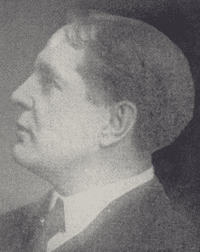
Dr. William Dudley, for whom the Vanderbilt Stadium is named
|
|
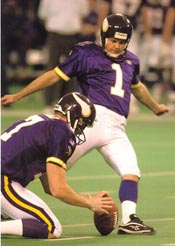
Gary Anderson
|
In 1998, South Africa native Gary Anderson became the first placekicker in NFL history to convert all his FG attempts (35) and extra points (59) in the regular season.
- Anderson had his great season at age 39 for Dennis Green's Minnesota Vikings, who went 15-1 in the regular season to earn the #1 seed in the NFC Playoffs.
- After the bye week, the Vikings defeated Arizona 41-21 in the Metrodome to reach the NFC Championship Game against Atlanta.
- Anderson booted FGs of 39 and 45 yd in Q2, his 44th and 45th straight dating back to the previous season.
- With the Vikings leading 27-20 and 2:07 left, Anderson finally missed on a 38-yarder that would have clinched the game.
- Given new life, the Falcons drove 71 yards to score on a 16-yd pass from Chris Chandler to WR Terance Mathis to send the game into OT.
- With 3:08 left in the OT, 38-year-old Morten Andersen, a native of Denmark, kicked a FG – from the same 38-yd distance from which the other Anderson had missed – to send Atlanta to its first Super Bowl.
Gary Anderson continued in the NFL until age 45. Morten Andersen kept kicking until age 47.
|
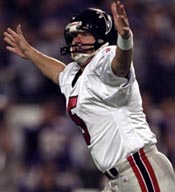
Morten Andersen |
|
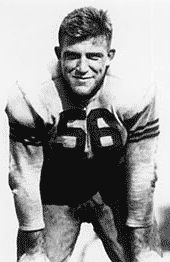
Bill Hewitt
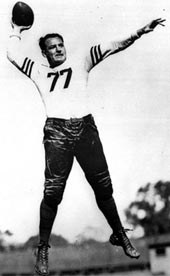
Red Grange
|
In the summer of 1933, Arch Ward, Sports Editor of the Chicago Tribune, staged the first major league baseball All-Star Game at Comiskey Park in the Windy City. Emboldened by the success of that venture, he began the annual College All-Star Game the following year.
- On August 31, 1934, a team of college graduates faced the NFL Champion Chicago Bears at Soldier Field.
- 79,432, the largest crowd to witness a sporting event in the nation so far that year, watched the All-Stars battle the Bears to a scoreless tie.
- George Kirksey wrote this in his United Press story on the game: "the
all-Americans piled up a total of
yardage and first downs that convinced most of those who saw the
game that the school boys can at least hold their own with their
mercenary brothers." The Stars made 6 first downs to 3 for the pro champs.
- The Bears threatened in Q2 when several passes put them on the collegians' 9. But E Bill Hewitt fumbled a lateral, and E Ed Krause of Notre Dame recovered to end the threat.
- E Wayland Becker blocked a punt by Bob Jones of Indiana in Q4, putting the Bears in business at the 19. But Joe Laws, "brilliant" QB from Iowa, intercepted a pass in the end zone and ran it out to the 11. Later in the period, George Halas's pros staged a mild threat. After an INT gave them the ball on their own 45, they moved to the All-Stars' 25 thanks mostly to a 25-yd aerial from Red Grange to Johnny Sisk.
- The All-Stars' best scoring chance came in Q3 when E Bill Smith of Washington just missed a 40-yd FG. Smith later missed another try of 42 yd.
The All-Star game at Soldier Field quickly became the traditional season opener for football fans.
- It was held every year through 1976. The final tally showed 31 wins for the pro champs to 9 for the collegians, with 2 ties.
- The game was cancelled in 1977. Pro teams had become increasingly concerned that their high draft choices would be injured in the game. And the defending champs weren't especially motivated to begin their next campaign with a no-win game against collegians.
|
|
Leland Stanford Jr. University opened with 559 students and 15 faculty membes on October 1, 1891.
- A short time after school began, a group of students interested in playing football called on John Whittemore to organize a team. Whittemore was a senior transfer from Washington University in St. Louis where he had played football.
- California had been playing football for over a decade. Roy Gallagher, the Bears' football manager, in that era a business and equipment manager rather than a coach or athletic director, issued a verbal challenge to Stanford to meet in a game on Thanksgiving Day, 1891.
- Whittemore felt his fledgling team would need more time to get ready. So he successfully pushed back the contest to March 19, 1892. In the meantime, he scheduled games with Hopkins Academy and Berkeley Gym as well as the Olympic Club. The Cardinal won the first two but lost the third.
- Whittemore required his players to pledge to do the following:
- To abstain absolutely from the use of tobacco and alcoholic drinks.
- To retire regularly not later than 10:30 p.m.
- Not to rise before 6:30 a.m.
- To obey implicitly and regularly the call of the manager for cross country running, gymnasium practice, and field practice.
- To abstain absolutely from eating between meals.
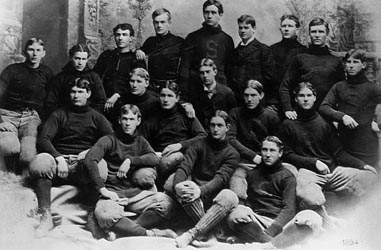
Stanford's 1891-2 football team; manager Herbert Hoover is third from the right in the last row.Stanford's football manager was a freshman who would become the university's most famous grad, Herbert Hoover.
- With the game scheduled for the 15,000-seat Haight Street baseball grounds in San Francisco, a neutral site between the two campuses, Hoover had 10,000 tickets printed.
- On game day, he sold out the printed tickets and began collecting cash for the additional seats and overflow areas. He tossed the coins into empty wash tubs, boxes, and anything else he could lay his hands on.
- When the team captains met with the referee shortly before game time, the three discovered that Hoover had forgotten one important item. No one brought a football!
- The owner of a local sporting goods store set out on horseback to get a ball. The game was delayed almost an hour until the pigskin arrived.
- "I did not see the game," Hoover said. "After the game, the California manager and I retired to a hotel with our money, now transferred to grain bags, and sat up most of the night counting it. I had never seen $30,000 before. We were well financed for the next season."
Stanford scored a major upset that day.
- The Cardinal surprised the stronger and more experienced Bears by scoring three touchdowns, worth 4 points each, and one PAT, worth 2, for a 14-0 halftime lead.
- Carl Clemens scored the first touchdown in the history of the Big Game when he took a handoff from Paul Downing on a reverse and sprinted 45y into the end zone.
- Clemens scored again on a 45y run, and Whittemore also tallied a touchdown and a PAT.
- Cal shut out the upstarts in the second half but could score only two touchdowns and one conversion to fall short, 14-10.
Reference: Stanford: Home of Champions, Gary Migdol |
|
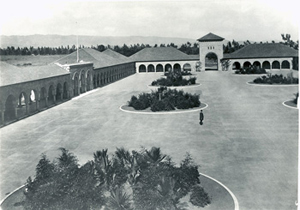 Stanford's Campus in 1891
Stanford's Campus in 1891
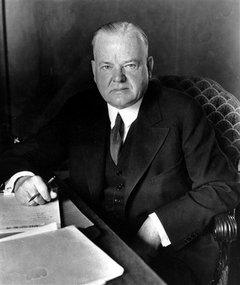
Herbert Hoover, U.S. President 1929-33
|
Game Broadcast Coast-to-Coast - I
October 28, 1922: Princeton @ Chicago

Amos Alonzo Stagg
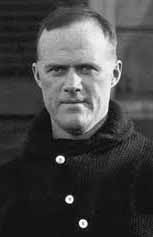
William Roper
|
When two esteemed coaches pick the same game as the most dramatic of their long careers, that contest merits attention.
- In 1922, Amos Alonzo Stagg, "the most revered man in the sport," was in the 31st year of what would be a 40-year tenure at the University of Chicago, a Western Conference (Big Ten) member until 1946 (although the school dropped football after the 1939 season). Stagg was known as a master strategist.
He was one of the first coaches to use the forward pass on the end of a double reverse; he pioneered double and triple passes behind the line, split buck, end-around runs, laterals, and line-shifts. Knute Rockne used to say, "All football comes from Stagg." His numerous innovations included: the huddle (1896); direct pass from center ('96); wind sprints ('96); man in motion ('99); unbalanced offensive line (1900); backfield shift ('04); numbering players ('13); cross-blocking ('18) ...
- The Princeton Tigers, making their first gridiron foray into the Midwest, were coached by alumnus William Roper, whose second term as head man at the school began in 1919 after he had served as a lawyer, insurance man, and Philadelphia city councilman. He remained Princeton head coach through 1930. In contrast to Stagg, Roper didn't specialize in tactics and techniques. He had no playbook. Instead, he "had a flare for grand strategy and could impart this to QBs." He let his players think for themselves. Occasionally, he would dictate a play - if an opponent had used it successfully against Princeton.
Roper was one of the last of the great romantic football coaches. Where other mentors were remembered for tricky systems and won-lost records, Princetonian Bill Roper will be forever associated with locker-room oratory, come-from-behind victories, and heart-stopping upsets.
One of his 1922 stars recalled: "Coach Roper was a true Princetonian from the old school. He convinced us that if we wore Orange and Black colors and the other side didn't, we had them licked."
|
The hype for the game reached epic proportions.
- Princeton brought a 4-0 record to the Windy City. The Maroons were likewise undefeated in three games. The Tigers sought revenge for the 9-0 beating Stagg's boys had administered in Princeton the previous season. However, Chicago was considered a 3-to-1 favorite over a Princeton team that even for that era was considered small.
- Stagg Field's 32,000 seats, including temporary bleachers in the end zone, had been sold out for weeks. If Chicago had offered standing room tickets, the crowd could have been much larger.
- It was the first football game heard coast to coast. The broadcast was carried on phone lines to New York City, where the nationwide transmission originated. People with receivers could listen in their own homes to one of the 200 radio stations across the nation. Countless others gathered around radios in Western Union offices and speakeasies. Back at Princeton, students crowded into the physics lab. It seemed as if everyone in the New Jersey town was within earshot of a radio tuned to station WOR in Newark.
The schools were not only highly esteemed academic institutions but had also carved out a reputation as football powers. Each squad also represented the aspirations of its section of the country.
- With Yale and Harvard, Princeton constituted the Big Three that had dominated football for 40 years, Princeton, of course, participating in what is considered the first college football game in 1869. The Tigers had disappointed the Eastern Establishment by losing to the upstarts from the Windy City the year before. Roper urged his minions to uphold the honor and tradition of the East.
- Chicago carried the aspirations of the heartland against the Elite East. Midwest football had received a boost in 1913 from an unexpected quarter when tiny Notre Dame had vanquished mighty Army 35-13 thanks to the passing combination of Gus Dorais and Knute Rockne. Chicago could give the section's esteem a booster shot with another victory over Princeton.
Before kickoff, the Chicago band took the field with what it proclaimed The World's Biggest Drum, Big Bertha.
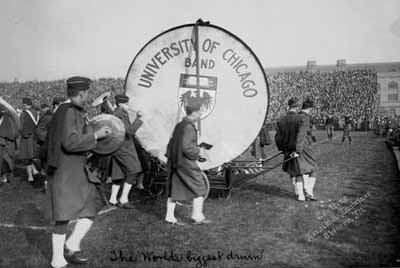
|
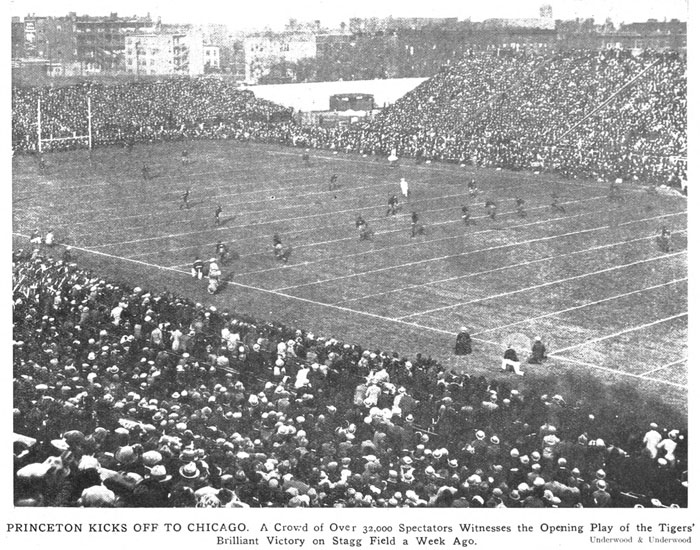 The Daily Princetonian
The Daily Princetonian, 11/4/1922 |
The first minutes of the contest illustrated the contrasting tactics of the two coaches.
- Princeton won the toss and elected to defend the north goal. The kickoff sailed into the end zone; so the Maroons began play at the 20.
- However, on the first play, O. E. Strohmeier punted to midfield. After accepting a 5y penalty on Princeton for offsides, Chicago punted again.
- Princeton lined up in punt formation but ran instead only to lose 3y. Illustrating what one Princeton player said about Roper's offense, "There was no rhyme or reason about [the plays], and none was keyed to any other play," next came a long pass, but Maroon captain Jimmy Pyott intercepted on his 15. Given momentum by the turnover, what did Chicago do? They punted!
- From its 45 after an offsides penalty, Princeton tried a double pass but E "Whoops" Snively was tackled for a 12y loss. Princeton punted across field to Pyott who was dropped at his 40.
 Princeton
Princeton-Chicago action 1922
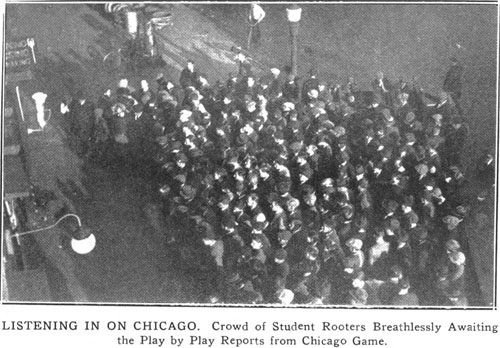 The Daily Princetonian
The Daily Princetonian, 11/4/1922
|
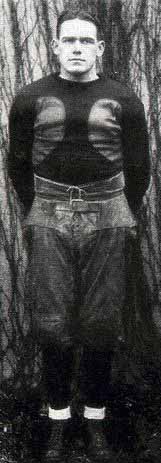
Chicago RB Johnny Thomas |
With favorable field position, Stagg unleashed his offense, which used a shift that seemed to baffle Princeton.
- Star back Johnny Thomas, a 22-year-old World War I veteran from Jamestown ND, carried seven times in 10 plays for 37y as the Maroon mass drove through the smaller Tiger linemen to the end zone for a 6-0 lead. A new rule for 1922 called for the ball to be placed at the five for the PAT, which could be scored by running or passing rather than the traditional placekick. The missed kick failed to dampen the enthusiasm of the confident Chicago crowd. The points were the first surrendered by Princeton all season.
In choosing Thomas for his 1922 All-American team, Walter Camp wrote:
John Thomas of Chicago has that rare art of carrying through his charge with his feet still under him, ready for a further drive. When he strikes, he strikes hard, but he has still a later thrust of power so that the ordinary check in a line does not stop his forward progress. ... His work shone in other games but it was particularly brilliant in the Princeton game. It is safe to say he did far more against the Princeton line in effective scoring than did any backs of the East who met the Tigers.
- Under the rules of the day, the team that was scored upon had the choice of kicking off or receiving the kick. Princeton chose to kick.
- As if sportingly saying, "We give you a chance now," Chicago punted on second down. But the strategy backfired as Jack Cleaves returned the ball from his 45 behind excellent interference to the Chicago 23.
- After two ground plays gained three, a third down pass fell incomplete. T "Pink" Baker then tried a drop kick from the 32 but missed.
- On the first play after taking possession, Pyott punted to QB Johnny Gorman (5'7" 154), who had missed the Chicago game the year before. Gorman made a fair catch on the Princeton 45.
Princeton then drove for its first touchdown.
- On third-and-four, Harry Crum, on a fake double pass, gained just enough for the first down. On the next play, Crum fumbled but recovered.
- Catching the Maroon secondary asleep, Snively shot a pass to E Howard "Howdy" Gray all the way to the seven. A penalty moved the ball to the five. Crum plunged up the middle for a yard as the period ended.
- Crum pushed forward for two, then a half yard. On fourth down, Cleaves squirmed over for the tying touchdown. Ken Smith kicked the goal that put the Tigers on top 7-6.
The Princetonians had made a statement that they didn't come west to be a sacrificial lamb. Game on!
|
 The Daily Princetonian
The Daily Princetonian, 11/4/1922
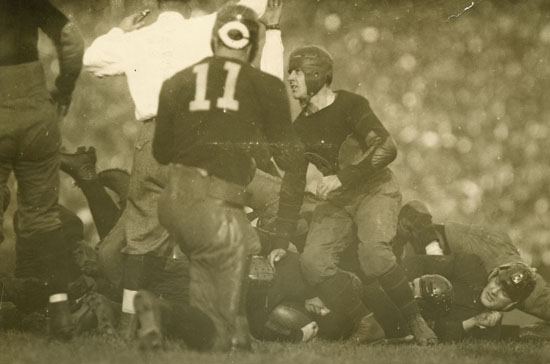
Thomas scores one of his touchdowns - possibly same one as above.
Archival Photographic Files, [apf4-00457], Special Collections Research Center, University of Chicago Library.
Continued below ...
References: College Football U.S.A. 1869-1971: Official Book of the National Football Foundation,
John D. McCallum and Charles H. Pearson
"Princeton Rallies And Beats Chicago," The New York Times, October 29, 1922
Top of Page
|
Game Broadcast Coast-to-Coast - II
October 28, 1922: Princeton@ Chicago
After Princeton had forged a 7-6 lead early in the second period, the Maroons fought back as any outstanding team would.
- Chicago chose to kick off to Princeton. The Tigers tried to punt back on first down, but the kick was blocked and went out of bounds on Princeton's 31.
- The Maroons capitalized on the break to retake the lead. Running behind the blocking of Joe Pondelik and Lloyd Rohrke, Thomas smashed through the line twice for 8y, then sprinted around left end on a double pass for a first down on the 17. Harry Thomas, John's brother, gained 5, then Johnny 2 and 4. On a fake end run, John Thomas roared into the end zone. A bad pass from center voided the EP try. Chicago 12, Princeton 7.
- At this point, W. L. Zorn replaced John Thomas. That meant that Thomas could not return until the second half. If he were replaced then, he was through for the afternoon.
|
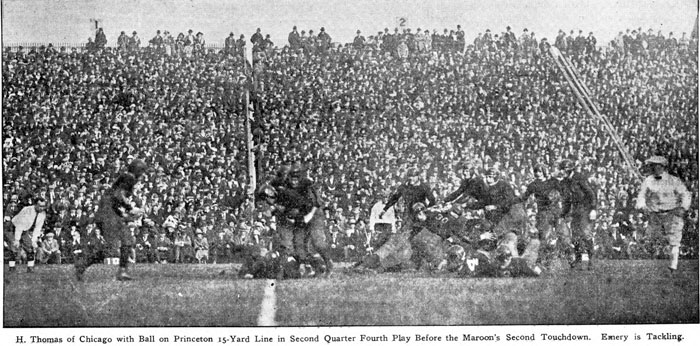 The Daily Princetonian
The Daily Princetonian 10/30/1922
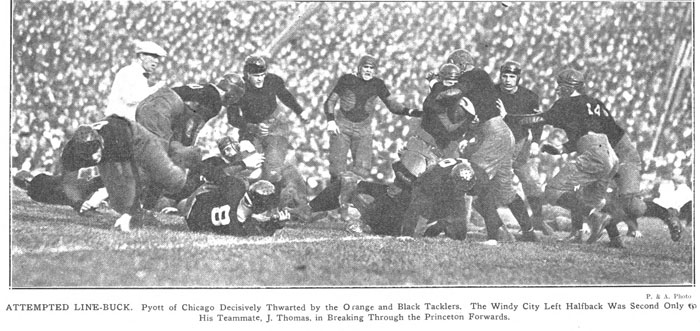
The Daily Princetonian, 11/4/1922
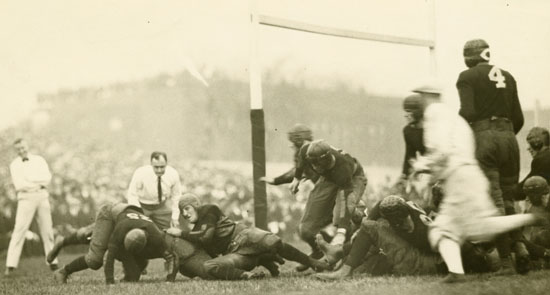
Archival Photographic Files, [apf4-00458], Special Collections Research Center, University of Chicago Library.
|

Harland "Pink" Baker
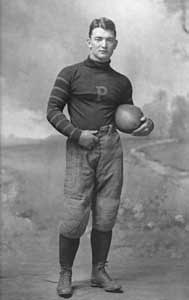
Johnny Poe

Howard "Howdy" Gray
|
With its defenders worn down, Princeton tried an onside kick.
- Cleaves recovered T "Pink" Baker's kick at the Chicago 35.
- After two runs gained four, Cleaves fired a pass to Smith to the 11. The Maroons stiffened, throwing first Gorman, then Van Gerbig for losses. Cleaves faked a drop-kick, then ran, but he too lost yardage.
- Smith tried a drop-kick for three points from the 25, but Fletcher blocked it. Strohmeier immediately punted to Cleaves, who signaled for a fair catch of the 45.
- The Black and Orange again pushed deep into Maroon territory. Bob Beattie gained six, then three on a feint of a double pass. Then he rammed through center for a first down on the 31.
- On third-and-seven, Beattie connected with the speedy Cleaves who ran to the 21. However, Beattie fumbled on the next play, and Franklin Gowdy recovered for Chicago. The half ended a few plays later.
We have no record of Coach Roper's halftime speech to his Tigers, but he probably reiterated the famous slogan of Johnny Poe '00, grandnephew of Edgar Allan Poe and Roper's teammate: "The team that won't be beat, can't be beat." Whatever coach said, the third period did not go well for the visitors.
- Gorman returned Chicago's kickoff to the Maroon 35. Cleaves punted on second down to Pyott who was tackled at his 29. The Maroons likewise punted on second down, but Princeton booted the hot potato right back on first down.
- Chicago actually ran two plays before punting, but Princeton was penalized for offsides. which gave the Maroons a first down.
- Pyott attempted to punt on third down, but Gray blocked it out of bounds on the Chicago 22. Given an excellent chance to retake the lead, Princeton sputtered. After two plunges gained 5, a double pass, Snively to Cleaves, failed. The Tigers tried the same play on fourth down. The pass was completed this time, but Cleaves was stopped inches short of the first down marker.
- Pyott wasted no time punting out to the 40, where Cleaves made a fair catch. After a second down pass fell incomplete 40y downfield, Princeton tried another aerial, this one bouncing off a receiver's hand into the arms of Burgess in maroon.
- Chicago ran five plays, making one first down, before punting to Gorman, who "twisted and wrestled" back to midfield. But Cleaves punted on first down to Jimmy Pyott, who returned it 6y to the 31.
- On third-and-5, Pyott kicked to Gorman, who was tackled on the 22. Princeton was penalized half the distance to the goal for illegal use of hands. Rushed hard, Cleaves botched a punt, which went only to his 28.
- Finally getting the field position he had been seeking, Stagg sent Johnny Thomas back in. Zorn smashed through C for 6. Thomas gained 2, then 0. On fourth-and-2, Thomas ripped through a hole in the Tiger defense for 15y to the 6. After Zorn gained nothing, Thomas plunged to the 2, then dove over RE beyond the goal line before being hurled back. Pyott tried his hand at kicking the extra point but failed. Still, Chicago seemingly had the game in hand with an 18-7 lead. But, to quote a phrase made popular 70 years later, "Not so fast, my friend!"
- Baker kicked off to Pyott, who returned the ball 20y to Chicago's 34 as the quarter ended.
Outweighed and worn down, Princeton would need a break to get back in the game.
- Pyott's nifty 14y end run gave the Maroons a first down. Despite completing its first pass of the game - for only 3y - Chicago had to punt. Gorman caught it on the 20, then surprised the onrushing Maroons by lateraling the ball to Cleaves who ran to midfield. However, an official ruled the ball had been passed forward illegally and placed the spheroid on the 1 - in effect, a 49y penalty.
- The prevalent strategy of the day called for Princeton to boot the ball out of danger. However, Roper had trained his lads to think outside the box. So QB Gorman called for punt formation with Cleaves back. But before the ball was snapped, Gorman whispered something in Jack's ear. Roper soon realized what Johnny said as Cleaves retreated to the back edge of the end zone to arch a pass to his QB who caught it on the run and continued to the 40 before being dragged down.
- Trying to take advantage of the momentum, Gorman called for the same combination on a reverse pass that lost 5y. Cleaves then punted but only to the Chicago 42.
- After Pyott failed to gain, Zorn went back to punt. The substitute center's snap hit him in the shoulder and caromed straight into the arms of the onrushing E Gray. "Clutching this gift from the gods," Howdy ran untouched for a touchdown. Smith's PAT made it 18-14.
Gray's dad, the president of the Union Pacific Railroad, wildly waved his program and clobbered a woman in the shoulder.
"Hey, that's my wife," a man shouted at him.
"Sorry," the excited father said, "but that was my boy who scored."
"Oh," the husband said. "Hit her again."
("1922: The team of destiny," John Blackwell, The Trentonian at www.capitalcentury.com)
|
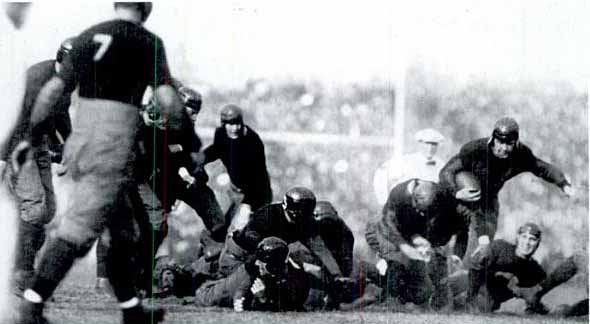
Princeton-Chicago action
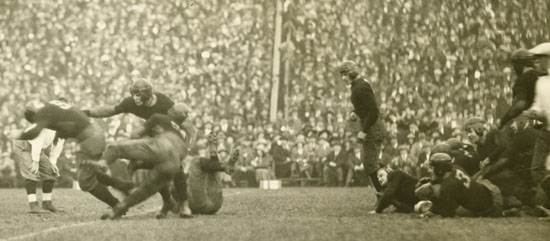
Thomas (#5) breaks loose through the Tigers.
Archival Photographic Files, [apf4-00459], Special Collections Research Center, University of Chicago Library.
For some reason - because Princeton had scored on defense? - Princeton kicked off.
- When the energized Tiger D stopped Thomas on third down, Chicago kicked to Cleaves at the Tiger 42.
- Jack fired a pass to Smith to the enemy 33. Cleaves took to the air again and was rewarded when Chicago was called for interference, placing the ball on the 18. Cleaves tore through the C for 3y, but Rohrke in maroon was offside, moving the ball to the 7.
- Cleaves battered for 3, then 1, before Ewer was thrown back. On the sideline, Crum, nicknamed "Maud" because of his mule-like kick on plunges, convinced Roper to sub him in place of Ewer for fourth down. Maud knifed into a mass of humanity. The four officials had to untangle the players before determining that the ball was over the line. Smith again booted the point. Princeton 21, Chicago 18.
Again, Baker kicked off, McMasters returning it to the 34.
- With little time remaining, Chicago had no choice but to pull out their neglected passing attack. Pyott hit L. L. McMasters twice to land the ball on the Princeton 45.
- Another pass over the middle resulted in an interference call on the Tigers, advancing the pigskin to the 25. After failing to gain on the ground, Pyott connected with Strohmeier to the 6.
- Twice the Maroons assaulted the Tiger line but gained only to the 2 1/2. Thomas then plunged to the 1.
- On fourth down with time ticking away, assistant coach Fritz Crisler ('22) urged Stagg to send in his son, Amos Jr., a backup QB, with orders to pass. But Amos Sr. shook his head. "I have to live with my conscience. Let the kids work it out by themselves."
- So Thomas hurled himself into the line yet again, but the converging defenders stopped him two feet from the goal line.
- The New York Times play-by-play ended thus:
Princeton kicked out of danger just as the whistle blew, and Chicago went down in the most sensational defeat of the year, leaving the East triumphant.
- In an interview nearly 70 years later, lineman Don Griffin, the last survivor of the '22 Tigers, revealed that Chicago was hampered in its last plays because the roaring crowd drowned out the signals. "We took credit for stopping them," Griffin said, "but the truth is their plays were messed up."
- Stagg was furious. He had been exhorting his charges all week and had reminded them at halftime not to get conservative in their play calls, especially near the goal line, and passes had moved them into position to score. But who could blame them for putting the ball into the hands of Thomas, who had scored all 18 points?
- For many decades, the game was considered one of the greatest upsets of all time.
|
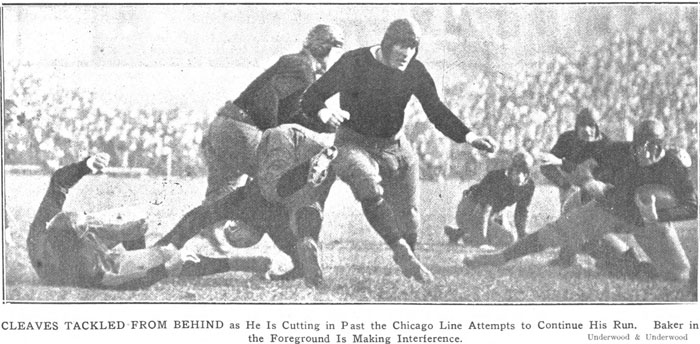 The Daily Princetonian
The Daily Princetonian, 11/4/1922
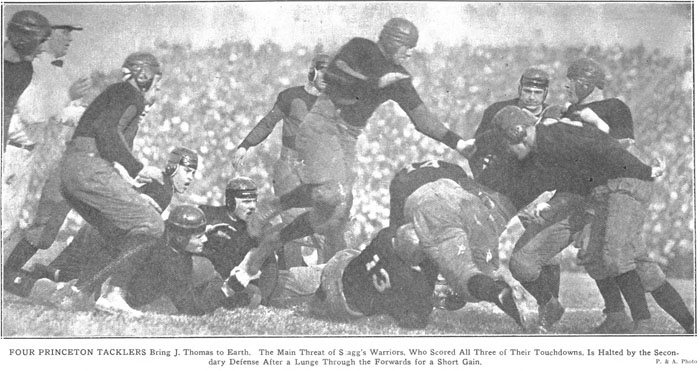 The Daily Princetonian
The Daily Princetonian, 11/4/1922
Typical of the reporting of the game was this passage from Walter Trumbull in The New York Herald:
The fourth period was one of the most thrilling in all modern football history. This was a period to talk about for years to come. It has always been the theory that it was the West that went in for the unexpected and the spectacular, and the East which stuck to the conservative, but right here Bill Roper's pupils pulled a play that was astounding in its aduacity, when on a forward pass from behind his own goal line, Gorman carried the ball to the 40-yard line.
The Princeton players held one of the greatest linebuckers that we have ever seen in a football field. Their stand was one of the gamest in the history of the game. The battle really ended on that last stand. It seems to us that from somewhere Johnny Poe must have looked down and smiled as he remembered that message which he once sent to a Princeton team, "If you won't be beat, you can't be beat."
1922 Princeton "Team of Destiny"
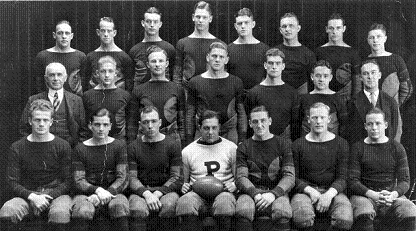
The player in white is presumably senior captain Mel Dickenson (LG).
The greatest sportswriter of the age, Grantland Rice, who had picked Princeton to lose to Chicago, proclaimed the Tigers the "Team of Destiny" after its stunning upset in the Windy City.
- The Tigers lived up to Rice's monicker, finishing the season undefeated with victories in the last two games over archrivals Harvard (10-3) and Yale (3-0).
- William Roper's Tigers have been retroactively selected National Champions for 1922 by the National Championship Foundation and the College Football Researchers Association.
Footage from Princeton's 1922 game against Yale
|
References: College Football U.S.A. 1869-1971: Official Book of the National Football Foundation,
John D. McCallum and Charles H. Pearson
" Princeton Rallies And Beats Chicago," The New York Times, October 29, 1922
Top of Page |
|
CONTENTS
Southern Athletic Conference
Perfect NFL Kicker
College All-Star Game
"The Big Game"
Game Broadcast Coast-to-Coast - I
Game Broadcast Coast-to-Coast - II
Football Firsts – I
Football Firsts – II
Football Firsts – III
Football Magazine
Golden Rankings Home
Top of This Page |



























